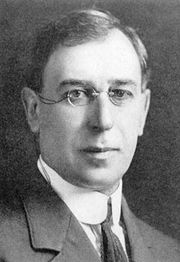
Moses Gomberg
In chemistry, radicals (often referred to as free radicals) are atomic or molecular species with unpaired electrons on an otherwise open shell configuration. These unpaired electrons are usually highly reactive, so radicals are likely to take part in chemical reactions. Radicals play an important role in combustion, atmospheric chemistry, polymerization, plasma chemistry, biochemistry, and many other chemical processes, including human physiology. For example, superoxide and nitric oxide regulate many biological processes, such as controlling vascular tone. "Radical" and "free radical" are frequently used interchangeably, however a radical may be trapped within a solvent cage or be otherwise bound. The first organic free radical identified was triphenylmethyl radical, by Moses Gomberg in 1900 at the University of Michigan.
Historically, the term radical has also been used for bound parts of the molecule, especially when they remain unchanged in reactions. For example, methyl alcohol was described as consisting of a methyl 'radical' and a hydroxyl 'radical'. Neither were radicals in the usual chemical sense, as they were permanently bound to each other, and had no unpaired, reactive electrons. In mass spectrometry, such radicals are observed after breaking down the substance with a hail of energetic electrons.
Depicting radicals in chemical reactions
In written chemical equations, free radicals are frequently denoted by a dot placed immediately to the right of the atomic symbol or molecular formula as follows
Chlorine gas can be broken down by ultraviolet light to form atomic chlorine radicals.
Radical reaction mechanisms use single-headed arrows to depict the movement of single electrons:
The homolytic cleavage of the breaking bond is drawn with a 'fish-hook' arrow to distinguish from the usual movement of two electrons depicted by a standard curly arrow. It should be noted that the second electron of the breaking bond also moves to pair up with the attacking radical electron; this is not explicitly indicated in this case.
In chemistry, free radicals take part in radical addition and radical substitution as reactive intermediates. Chain reactions involving free radicals can usually be divided into three distinct processes: initiation, propagation, and termination.
Initiation reactions are those which result in a net increase in the number of free radicals. They may involve the formation of free radicals from stable species as in Reaction 1 above or they may involve reactions of free radicals with stable species to form more free radicals.
Propagation reactions are those reactions involving free radicals in which the total number of free radicals remains the same.
Termination reactions are those reactions resulting in a net decrease in the number of free radicals. Typically two free radicals combine to form a more stable species, for example: 2Cl·→ Cl2
Free radicals play an important role in a number of biological processes, some of which are necessary for life, such as the intracellular killing of bacteria by neutrophil granulocytes. Free radicals have also been implicated in certain cell signalling processes [3]. The two most important oxygen-centered free radicals are superoxide and hydroxyl radical. They are derived from molecular oxygen under reducing conditions. However, because of their reactivity, these same free radicals can participate in unwanted side reactions resulting in cell damage. Many forms of cancer are thought to be the result of reactions between free radicals and DNA, resulting in mutations that can adversely affect the cell cycle and potentially lead to malignancy. Some of the symptoms of aging such as atherosclerosis are also attributed to free-radical induced oxidation of many of the chemicals making up the body. In addition free radicals contribute to alcohol-induced liver damage, perhaps more than alcohol itself. Radicals in cigarette smoke have been implicated in inactivation of alpha 1-antitrypsin in the lung. This process promotes the development of emphysema.
Free radicals in biology
Free radicals may also be involved in Parkinson's disease, senile and drug-induced deafness, schizophrenia, and Alzheimer's. The classic free-radical syndrome, the iron-storage disease hemochromatosis, is typically-associated with a constellation of free-radical-related symptoms including movement disorder, psychosis, skin pigmentary melanin abnormalities, deafness, arthritis, and diabetes mellitus. The free radical theory of aging proposes that free radicals underlie the aging process itself, whereas the process of mitohomesis suggests that repeated exposure to free radicals may extend life span.
Because free radicals are necessary for life, the body has a number of mechanisms to minimize free radical induced damage and to repair damage which does occur, such as the enzymes superoxide dismutase ( SOD), catalase, glutathione peroxidase and glutathione reductase. In addition, antioxidants play a key role in these defense mechanisms. These are often the three vitamins, vitamin A, vitamin C and vitamin E and polyphenol antioxidants. Further, there is good evidence bilirubin and uric acid can act as antioxidants to help neutralize certain free radicals. Bilirubin comes from the breakdown of red blood cells' contents, while uric acid is a breakdown product of purines. Too much bilirubin, though, can lead to jaundice, which could eventually damage the central nervous system, while too much uric acid causes gout

